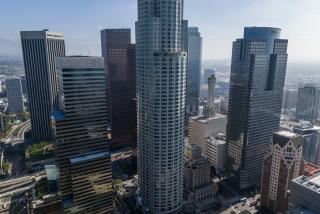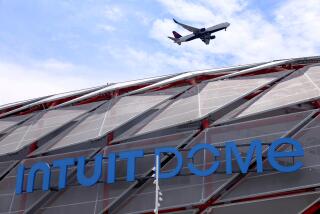Sprinkler Shock
“The sprinklers were wonderful. Without them, this building might have gone up,” said the supervisor in the 28th-floor office where a fire started to burn in the Wells Fargo Tower earlier this week. Without them, more high-rise buildings could go up in flames as the First Interstate Tower did in May. But the state Legislature has severely compromised efforts to provide protection for tall buildings and the people who work in them.
Fire-safety experts and most people who work in high-rise buildings agree that sprinkler systems can snuff out fires before they have a chance to spread into disasters. First Interstate Tower was installing sprinklers, but they weren’t ready yet; the fire gutted four floors and killed one man. Wells Fargo Tower, built since sprinklers were required in all new buildings, escaped with only minor water damage to six floors. The moral is clear.
The measure that the Legislature just passed started out on the right course as it went through the Senate, but it was badly weakened by amendments in the Assembly. The measure would give owners of both commercial and residential high-rise buildings constructed before 1974 one year to file a plan for installing sprinklers and three years to do the job. If owners needed more time, they could apply for three more years. They could get two more on top of that by demonstrating difficulty in removing asbestos. That’s nine years.
The Building Owners and Managers Assn. and the California Hotel-Motel Assn. lobbied hard forchanges in what they considered an unrealistic timetable. They also wanted tax credits. But most of all they wanted a shield from the strict schedule for compliance in Los Angeles, and they got it. Los Angeles City Fire Chief Donald Manning estimates that 40% of the commercial buildings covered by the state law are in the city.
The bill’s sponsor, Sen. Art Torres (D-Los Angeles), insists that the extensions would not be automatic, but there they are, and it’s a sure bet that many economy-conscious owners would apply for them. True, local fire officials would have to pass on any extensions, but the fact that delays would be possible under the law would make it difficult to deny requests.
The Legislature’s timetable differs starkly indeed from that in a Los Angeles city ordinance requiring sprinklers in older high-rise office buildings in three years. Owners with problems removing asbestos get an additional year to do the job. The City Council applied its ordinance only to office buildings and put off until October considering sprinklers for older residential high-rises, which are included in the state bill. That lapse taints the city’s reaction against the state bill, but it doesn’t change the fact that the state would preempt tough local action with a weaker law.
The conclusion jumps out like flames from a high-rise fire: The legislators bungled the job. The only way the mess can be cleaned up is for Gov. George Deukmejian to listen to the pleas of Los Angeles officials and veto the bill.
More to Read
Sign up for Essential California
The most important California stories and recommendations in your inbox every morning.
You may occasionally receive promotional content from the Los Angeles Times.










